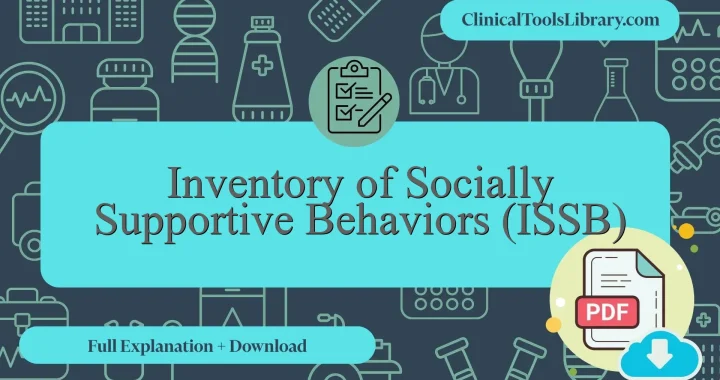In this article, we explain everything you need to know about the Inventory of Socially Supportive Behaviors (ISSB). We will cover the aspects it evaluates, the target population, a detailed step-by-step explanation, and how to interpret its results. Additionally, we will dive into the scientific evidence supporting this tool (diagnostic sensitivity and specificity) in clinical assessment. You will also find official and unofficial sources available for download in PDF format.
What does the Inventory of Socially Supportive Behaviors (ISSB) assess?
The Inventory of Socially Supportive Behaviors (ISSB) is a validated instrument designed to assess the frequency and types of supportive actions received by individuals within their social networks. Its primary purpose is to quantify tangible and emotional support, including assistance with daily tasks, provision of emotional encouragement, and availability of informational aid. The ISSB is frequently utilized in clinical research to evaluate the impact of social support on health outcomes, particularly in populations affected by chronic illnesses and mental health conditions. Comparative measures, such as the Social Provisions Scale, complement the ISSB in providing a broader understanding of social support dimensions. Scholars and practitioners often reference the Inventory of socially supportive behaviors issb pdf and related studies indexed on Google Scholar to ensure methodological rigor and applicability in diverse healthcare settings.
For which type of patients or populations is the Inventory of Socially Supportive Behaviors (ISSB) intended?
The Inventory of Socially Supportive Behaviors (ISSB) is indicated primarily for patients experiencing chronic illnesses, such as cardiovascular disease, diabetes mellitus, and cancer, where evaluating perceived social support contributes to treatment adherence and psychological well-being. It proves most useful in clinical contexts focusing on psychosocial interventions, rehabilitation, and mental health assessments, aiding clinicians in quantifying the frequency and type of tangible social support received. Utilization of tools like the ISSB allows for targeted support strategies in populations vulnerable to social isolation and stress-related comorbidities. Comparative studies involving the Social Provisions Scale underscore the ISSB’s specificity in capturing practical assistance, which is critical in managing complex care regimens documented extensively in the Inventory of socially supportive behaviors ISSB pdf resources accessible via Google Scholar.
Step-by-Step Explanation of the Inventory of Socially Supportive Behaviors (ISSB)
The Inventory of Socially Supportive Behaviors (ISSB) consists of 40 items designed to evaluate the frequency and type of supportive behaviors an individual receives in daily life. The instrument includes questions categorized into instrumental, emotional, and informational support, with each item prompting respondents to indicate how often they have received specific forms of assistance over a defined period, typically the past month. Response options utilize a Likert scale ranging from “Never” to “Very Often,” enabling quantitative assessment of perceived social support. Clinicians administer the ISSB by instructing participants to reflect on recent experiences related to chronic conditions such as diabetes or cardiovascular disease, where social support plays a critical role. Scoring is conducted by summing individual item responses within each support category, facilitating identification of areas requiring intervention to enhance patient outcomes.
Downloadable Inventory of Socially Supportive Behaviors (ISSB) PDF Resources in English & Original Language
Downloadable resources featuring the Inventory of Socially Supportive Behaviors (ISSB) are available below in both the original language and English versions, provided in PDF format for ease of use. These materials serve as essential tools for researchers and practitioners seeking standardized methods to assess social support dynamics within various populations. The Inventory of Socially Supportive Behaviors ISSB PDF files include comprehensive examples and instructions to facilitate accurate administration and scoring, supporting evidence-based approaches in healthcare settings.
How to interpret the results of the Inventory of Socially Supportive Behaviors (ISSB)?
The Inventory of Socially Supportive Behaviors (ISSB) test quantifies the frequency and types of supportive actions received by an individual over a specified period, typically the past month. Scores are calculated by summing item responses, with higher totals indicating greater perceived social support. Reference ranges vary by population but generally, a total score below 20 suggests insufficient social support, whereas scores above 40 denote robust social networks. For example, if the total ISSB score is 15, it may reflect potential vulnerabilities to stress-related conditions such as depression or cardiovascular disease. Healthcare professionals can utilize these results to identify patients who might benefit from interventions aiming to enhance social connectivity, recognizing the direct correlation between social support levels and treatment adherence, recovery rates, and overall mental health outcomes. The formula for the total score is T = Σ_i=1^n S_i, where S_i represents the score for each item and n the number of items completed.
What scientific evidence supports the Inventory of Socially Supportive Behaviors (ISSB) ?
The Inventory of Socially Supportive Behaviors (ISSB), developed by Barrera in the 1980s, has undergone rigorous validation to establish its reliability and construct validity within diverse populations. Empirical studies have consistently demonstrated that the ISSB effectively quantifies the frequency and types of supportive actions, distinguishing between emotional, instrumental, and informational support. Psychometric evaluations report satisfactory internal consistency coefficients (Cronbach’s alpha values typically exceeding 0.80) and test-retest reliability over periods ranging from weeks to months. Moreover, the ISSB’s sensitivity is evidenced by its correlational findings linking increased social support behaviors to improved outcomes in patients with chronic illnesses such as cardiovascular disease and diabetes mellitus. Its application in longitudinal research has further substantiated the predictive validity of the ISSB concerning psychological well-being and physical health metrics, reinforcing its role as a robust tool in assessing social support mechanisms within clinical and community health settings.
Diagnostic Accuracy: Sensitivity and Specificity of the Inventory of Socially Supportive Behaviors (ISSB)
The Inventory of Socially Supportive Behaviors (ISSB) has demonstrated variable sensitivity and specificity depending on the population and context in which it is applied. Studies indicate that the ISSB exhibits a sensitivity ranging from approximately 0.70 to 0.85, effectively identifying individuals with inadequate social support. Specificity values have been reported between 0.65 and 0.80, reflecting its capacity to correctly classify individuals with sufficient social support networks. These metrics underscore the ISSB’s utility as a reliable tool for assessing social support, particularly in clinical settings addressing chronic illness and mental health disorders. However, variations in psychometric properties may occur based on sample characteristics and cultural factors, warranting cautious interpretation of results.
Related Scales or Questionnaires
The Inventory of Socially Supportive Behaviors (ISSB) is comparable to several scales and questionnaires, such as the Social Provisions Scale and the Medical Outcomes Study Social Support Survey. The Social Provisions Scale assesses perceived social support across multiple dimensions, offering a broader psychosocial context compared to the ISSB’s focus on tangible supportive behaviors; however, it may be less sensitive to behavioral frequency. The ISSB provides detailed information on specific supportive actions, which can be advantageous in clinical settings targeting chronic illness management and mental health interventions. While the Medical Outcomes Study Social Support Survey covers emotional and informational support, it is lengthier and may increase respondent burden. Each of these tools, including the ISSB and its variants such as the ISSB PDF and ISSB example formats, are thoroughly explained and available for download on ClinicalToolsLibrary.com to facilitate appropriate clinical selection.




